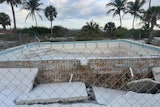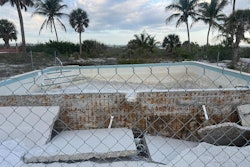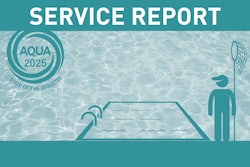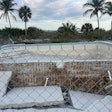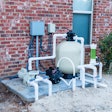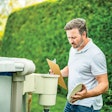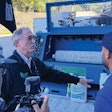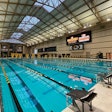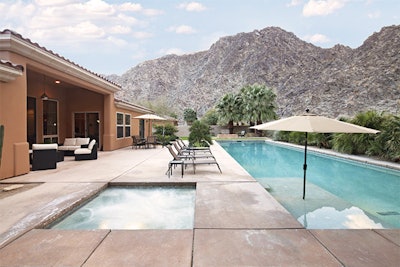
Information basis for this article was provided by Que Hales, manager of the Pool Chlor in Tucson, a large residential service business serving more than 2,000 customers. Hales also does research and education as a partner in onBalance, a pool chemistry consulting group.
While water is water no matter what state you’re in, many considerations of pool service change depending on where your customers live. Climate and geography affect the amount of rain, ambient heat, UV radiation, vapor pressure — even the type of dust and debris that is likely to come wafting over the fence and land in the deep end. And that changes the approach to pool care.
For example, the short summers and occasional furious storms of the upper Midwest create different challenges than the extended, humid swim season of southern Florida, and these are quite distinct from the focus of this story, the arid Southwest.
This region with its baking sun and desiccated ambience — stretching from inland California all the way to Texas — incorporates a huge segment of the overall U.S. pool market. Why? Because it’s dry and hot — and that makes people long for a dip in a pool.

The first thing to consider here is the effect on chlorine, the centurion of recreational water care. The biggest loss of chlorine in a desert pool is not to sanitizing — that is, the consumption of chlorine in the process of killing and oxidizing bacteria, organic waste and algae. Most of the chlorine leaves the pool through UV exposure and evaporation.
And that’s because desert days are scorching, there’s a lot of UV radiation bouncing around, and water evaporates like it’s going up a straw. These elements conspire to drain a pool of chlorine more quickly than any other region in the country. In order to compensate for that, more chlorine must be added more frequently and higher levels of cyanuric acid should be maintained.
Cyanuric acid bonds with chlorine and slows its UV decay rate. That chemical bond is the perfect strength for the purpose — it’s strong enough to hold the Cl atom in the molecule and protect it from UV, but it’s weak enough to release it to allow it to do its work when something needs to be sanitized or oxidized.
Vanishing Act
Climb out of a pool in the desert and you’ll be astonished at how cold a hot day has become. This is because the water on your skin is very rapidly absorbing heat energy from your body as it hastily changes state from liquid to vapor. The extreme low humidity in arid regions causes a very high evaporation rate from wet skin and swimming pools alike.
Uncovered pools can be expected to lose about a quarter inch of water per day in the wintertime and up to a half an inch of water per day in summer, depending on exactly how hot and dry it is. Add up those quarter inches and you realize that total evaporation can approach the equivalent of the whole volume of the pool over the course of a year.
The fluid leaving the pool in this process is essentially distilled water and dissolved gases. What remains is mostly calcium, salt and trace metals such as copper and iron. In order to keep the pool topped up, fresh water must be added, which, in the arid Southwest, tends to be pretty hard (full of minerals). So this process — evaporating out distilled water, leaving behind dissolved solids, and adding more hard water, is a process well designed to concentrate the amount of calcium and salts and other dissolved solids in the pool.
This concentration of solids happens more quickly than it does elsewhere in the country where it’s not as hot and dry, and where water is softer. And it’s not just the elements and salts that grow ever more dense;anything else that comes into the pool such as algaecides and clarifiers and unoxidized bather load concentrates as well.
Calcium is the main concern. According to the APSP standard, calcium hardness should be a minimum of 150 ppm, the ideal is 200 to 400 ppm, and the maximum is 1000 ppm. When calcium levels reach 1000 ppm, it is recommended that you drain and refill.
With the concentrating cycle of rapid evaporation and hard water refill, it can take a pool perhaps four or five years to hit that 1000 ppm calcium level. Calcium hardness is a problem because a pool loaded up with the stuff is just looking to dump it somewhere as a precipitate. A slight rise in pH is all it takes — it may drop out in the heater, it may deposit on the plaster or somewhere else, but none of these developments make pool owners happy.
Along with calcium, TDS also becomes concentrated by this process. TDS is an umbrella term that refers to a number of substances, but it also includes disinfection byproducts or DBPs — organic waste that’s been chlorinated but doesn’t completely go away. And some of these DPBs can make people sick.
Chloroform trihalomethane is one such DBP. There’s no recommended test for chloroform trihalomethane in swimming pools, so the pool standard accounts for its potential buildup by dictating a drain when the TDS increases by 1500 ppm from the startup point.
This is a little problematic, because DBPs rise according to bather waste and bather load, but we keep track of them by measuring TDS, which enters the pool by other means. So using the increase in TDS as a surrogate for the rise in DBPs is not a precise way of controlling DBP load. We just don’t have a better way of doing it.
You also have, in arid regions, a great deal of dust just blowing around and landing in the pool. Desert dust is very alkaline and contains a lot of calcium, so of course as it dissolves in the pool it increases the pool’s calcium levels and pH.
Breakdown In The Sun
Finally, the desert heat and sun have a strong impact on materials and equipment. All plastic components of the pool system, from the filter to the pool cover, suffer UV breakdown much faster under the relentless baking sun. These items have UV blockers in them, and that helps, but not as much as an overcast sky.
Also, summer temperatures often reach into the hundreds, and this places high stress on pumps. Any engineer will attest that heat is the great enemy of the pump motor. If there’s a choice, it is a good idea to run pumps at night when temperatures drop. Over time, generally speaking, this will increase the life of the motor. And that also uses off-peak energy, which the utilities like. If it’s a loud pump, however, the neighbors may be less enthusiastic.
Mostly, pool care in the desert comes down to replacing what the extreme climate extracts.
The elements that define a desert — intense sun and dry heat — which make pool ownership so desirable are the same ones that impact pool care most and make it a challenge. With water drawing up the to the sky and the merciless sun beating down, pool care professionals must take special measures to compensate losses to the arid environment.
Desert Rains
Although no desert dweller will complain about rain, when it comes it brings its own challenges to pool service.
Monsoon season in the desert simply means that a greater percentage of the annual rainfall is concentrated in mid-July to mid-August.
Monsoons mean more water — enough to overflow some pools and require draining or extended backwashing to keep the levels down to normal. In some cases, this can result in altered chemistry, including dilution of stabilizer or other treatment chemicals.
It also means mustard algae. When it rains, algae spores are rinsed into pools, making pools more susceptible to algae this time of year. And some strains are more resistant to chlorine than normal, which means more aggressive treatments may be necessary.
After the rain comes the mud. When desert terrain merges with urban development, abundant opportunities arise for a short concentrated rainfall to wash mud into swimming pools. When landscapers are not careful, or when normal storm drainage is overwhelmed, service techs find themselves mucking out a brown mess rather than maintaining a blue oasis.
And on the service route, keep in mind that motor vehicle traffic is more challenging in these heavy microbursts of desert rain. Wipers need to be in excellent condition, brakes need attention, hydroplaning is common, and loads need protection from the unusual weather. In the desert, more fender-benders happen on the rain- and oil-slicked roads than other times of year.
Comments or thoughts on this article? Please e-mail [email protected].



















